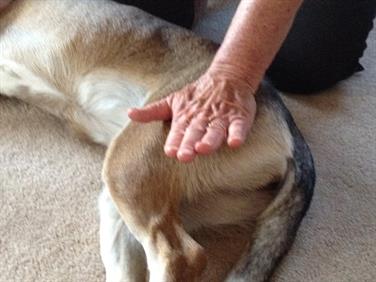
Learn Tui Na Techniques for Your Horse, Dog & Cat Health
Part II – “Ouch” Points: The Cold, Hard Truth about Ah-Shi Points
In Part One of this two-part series, we went over the nature of Ah-Shi points. We discussed how the muscle tissues tighten and become knotted. This can occur spontaneously due to physical or emotional stress, injury or disease. The result is the same: the tissues shut down, not allowing blood and chi to flow. The animal then experiences pain, which leads to restricted movement.
When Ah-Shi points and the surrounding tissue are not addressed quickly, the animal tends to compensate to avoid pain. This leads to the horse’s, dog’s, or cat’s entire body becoming physically compromised. What may have begun as a minor tightness can snowball into a major lameness. Acupressure-massage, called Tui-Na in Chinese, is a highly effective hands-on bodywork modality that is known to resolve Ah-Shi points and the surrounding tissues.
Tui Na
Tui Na is one of the five main branches of Traditional Chinese Medicine (TCM) along with diet, chi gong, herbs, and acupuncture. It is considered the original Chinese meridian massage. Tui Na is pronounced “Tway” with a long “a” sound and “Nah.” Translated, Tui Na means “push – grasp.” It has been continuously practiced in China for both humans and animals since 2700 B.C. Over time, these techniques followed the Silk Road to the Middle East and on up through Europe to Northern Europe.
Tui Na regulates meridians by promoting the circulation of chi, blood, and other vital substances. This, in turn, provides the energetic and nutrient nourishment necessary for the internal organs to function properly. When there’s a harmonious flow of vital substances, all the bodily tissues are nourished, and Ah-Shi points are less likely to form. However, if they do, they can be easily resolved with these hands-on techniques that have been used for centuries.
Tui Na Techniques
The first Tui Na technique is direct pressure, called An Fa. Begin pressing very lightly because the point can really hurt. Come away from the point and then press ever so slightly more into the point using the soft tip of your thumb, knuckle, or the heel of your hand. There are many variations of how to apply An Fa including crossed-hands or an elbow on larger equine muscle masses.

Tui Fa is a “pushing” technique that is used to trace a specific meridian that is blocked along its path and possibly where an Ah-Shi point has formed. The hand movement needs to be relaxed, smooth and consistently sliding along the meridian. Sliding up and back using the soft tip of the thumb, three fingers, or the heel of the hand removes obstructions and can invigorate the flow of chi and blood.

There are a huge number of Tui Na techniques to enhance the effectiveness of an acupressure-massage session that is best learned by taking hands-on training courses. The general purpose of using Tui Na techniques is to invigorate the harmonious flow of vital substances throughout the animal’s body to help resolve painful Ah-Shi points.
